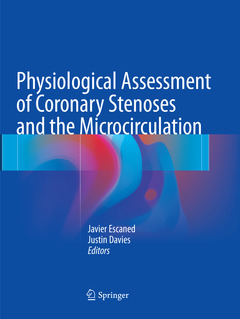Physiological Assessment of Coronary Stenoses and the Microcirculation, Softcover reprint of the original 1st ed. 2017

Javier Escaned MD PhD FESC is Head of Section (Interventional Cardiology) at Hospital Clinico
San Carlos, and Associate Professor of Medicine at Complutense University (Madrid, Spain). He
trained as a cardiologist the United Kingdom (Queen Elizabeth University Hospital, Birmingham
and Walsgrave Hospital, Coventry) before moving to the Thoraxcenter / Rotterdam (The
Netherlands), where he obtained his PhD degree in 1994. He is author of more than 250 scientific
articles, books and book chapters on different aspects of interventional cardiology, imaging and
physiology. He is co-editor with Patrick Serruys of the textbook “Coronary Stenosis. Imaging,
Structure and Physiology”, whose new edition was launched in May 2015. Current positions in
scientific societies include: board member (treasurer) of European Association of Percutaneous
Cardiovascular Interventions (EAPCI), nucleus member of the ESC Working Group on
Pathophysiology and Microcirculation, and co-director of EuroPCR. In 2014 he served as director of
the ESC International Summit on Coronary Microcirculation and Heart Disease. Recent or on-going
international multicentre trials in which he has a principal investigator role include: ADVISE II,
SYNTAX II, PILOT SECRET, SHEAR STENT and DEFINE-FLAIR. Some of his additional
interests are philosophy, education and music.
Date de parution : 08-2018
Ouvrage de 313 p.
21x27.9 cm
Disponible chez l'éditeur (délai d'approvisionnement : 15 jours).
Prix indicatif 121,31 €
Ajouter au panierDate de parution : 08-2017
Ouvrage de 313 p.
21x27.9 cm



